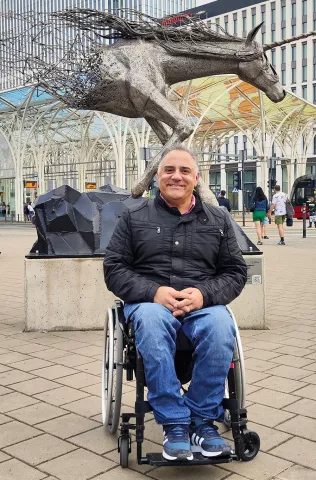
“Feet, what do I need them for
If I have wings to fly.”
Frida Kahlo
Disability, functional diversity, or as I like to call it: people who face life with a challenge (physical, sensory, cognitive…) are part of our lives, our society, and the diversity of humanity. However, invisibility, ignorance, and exclusion add an extra layer of difficulty that hinders the full development of a person.
In a university setting, this topic needs to be tackled from multiple angles to ensure inclusion at all levels, enriching the whole community. Ensuring equal opportunities is one of the traditional goals of a university, and to achieve that, it’s the institution itself that must adapt to the person facing a challenge—not the other way around—whether they are a student, professor, or staff member.
Accessibility. It’s not just an architectural issue, though inclusive design should be a necessary (though not sufficient) condition. Ramps, elevators, classrooms, restrooms, or workstations should be designed for any type of challenge. Additionally, educational materials must also be inclusive: various formats and font sizes, audiobooks, braille texts, or assistive technologies must ensure full participation in academic and extracurricular activities.
Psychological Barriers. Ignorance, stigma, or discrimination might seem outdated, but they’re still prevalent today. Promoting an inclusive, participatory, and diverse environment helps foster empathy and understanding of functional diversity. It also strengthens the educational experience and critical thinking.
Diversity. Students, faculty, and staff facing challenges bring new perspectives that inspire innovation, creativity, and global solutions. Shifting the focus from limitations to different abilities motivates people, helps them thrive, and plants the desire to excel.
Education and Awareness. Educating and raising awareness toward an inclusive environment helps eliminate ignorance and prejudice. When university professors focus on a student’s abilities and potential instead of their limitations, it motivates them to achieve their best academic performance. The role of tutoring, designing extracurricular activities, or collaborating with organizations that support functional diversity are some of the ways to head in the right direction.
The university is the key social agent in ensuring that functional diversity is seen as a valuable resource that enriches the educational experience of everyone involved and better prepares them for a future (that must be inclusive). The goal should be that by the end of their university journey, graduates become agents of change to create a more inclusive, equitable, and enriching society for all.
Me and my time at TUL
Maybe because of my personality and way of being, I’m not usually representative of the population facing challenges. Independent, entrepreneurial, former rugby player… When a car accident suddenly caused me to become paraplegic and start living on wheels, it only slowed me down for a few months (hospital time). From then on, I was determined to get back to doing everything I wanted, just in a different way.
As a student, maybe because of the times, I had to fight for the most basic rights of people facing challenges, which at that early stage meant ensuring the university didn’t present any barriers. In the university, it was easier than in real life. That’s how I perceived it during my time at TUL. A university that has made a strong effort to eliminate architectural and psychological barriers, allowing a student to fully develop regardless of their different abilities. Although my stay was short and it wasn’t my goal to check out all the educational measures in place, I do believe there is a firm commitment to making TUL a universal institution.
In my role as a professor, there’s always some surprise. Although social norms are pretty inclusive now, when you take on a leading role, the rest of the audience is surprised. It happened when I was a DJ, when I was a politician, when I ran a local newspaper, when I started my businesses, when I did water skiing, and it still happens today when I’m giving a lecture or teaching a class. At TUL, there was also that initial shock or surprise among students at the start of a class.
And just like in my country, in Lodz, I noticed the difference between the university and the rest of the city. The university is always ahead of the curve. The city, well… it depends. New places are accessible, the “old” ones not so much. Older people were more surprised to see me, younger ones weren’t. Museums, shopping centers, public buildings… they’re accessible. Shops, restaurants, the streets… not always.
In short, my experience in Lodz and at TUL has been very positive in every way, and my personal challenge hasn’t posed any extra difficulty. It’s been a warm and wonderful stay, with high-level professionals (teachers and staff) and very interesting and engaged students. I think those “initial shocks” I mentioned will fade with more visits. See you soon!
Dr. Manuel Escourido-Calvo
Innovative Business Manager, Consultant and Lecturer at Universidad A Coruña;
visited Lodz University of Technology under Erasmus programme.